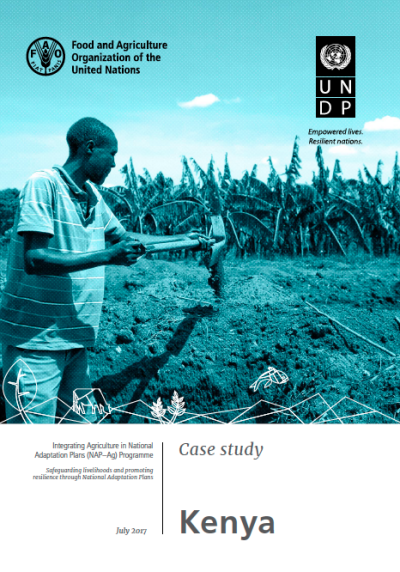
This country case study on Kenya is one in a series that describes the steps taken to formulate and implement National Adaptation Plans (NAPs), with a particular emphasis on adaptation in agriculture (incl. forestry, livestock and fisheries). This series aims to provide national policy makers with valuable information from colleagues and counterparts in Asia, Africa and Latin America who are on the same NAP journey to address the multiple challenges posed by climate change. Each case study describes the contribution and lessons learnt from the UNDP–FAO programme Integrating Agriculture in NAPs (NAP–Ag), which is funded by the German Federal Ministry for the Environment, Nature Conservation and Nuclear Safety (BMU) through the International Climate Initiative (IKI). The important contribution of this work to achieving national and international development and climate change goals (e.g. particularly the Paris Agreement and the Sustainable Development Goals) is also presented. Where possible, the case study series also aims to show the links between NAP and NAP–Ag programme activities and the resulting impacts. Given that the NAP–Ag programme in Kenya has only been running since mid–2016, it is too early to assess the impacts, however lessons can be drawn from the suite of activities that are being developed or implemented at the national and county level. The preparation of this case study is based on interviews with the UNDP–FAO NAP–Ag country coordinator, representatives from national Ministries with climate change adaptation responsibilities, as well as extensive review of country reports and publications.
Highlights
- The need to adapt to changing climatic conditions is urgent in countries such as Kenya. Over 80 percent of the population, and especially those living in rural areas, derive their livelihoods mainly from agricultural activities that are susceptible to climate change. The agricultural sector also contributes 26 percent of the Gross Domestic Product (GDP), and is therefore critical for the economic prosperity of the country.
- Kenya has an advanced suite of national adaptation policies, strategies, laws and plans in place. The Kenyan National Adaptation Plan 2015–2030 (NAP) was finalized in 2015, and was one of the first NAPs to be launched in Africa and globally by a developing nation. The NAP supports the 2010 Constitution of Kenya and the Kenyan Vision 2030 for a sustainable future and important role for agriculture in national development.
- The Kenyan NAP is aligned with UNFCCC technical guidelines on National Adaptation Plans (2012) and the Paris Agreement on climate change.
- The highest level of political support is given to planning, implementing and reporting climate change measures, with the President of Kenya sitting as chair of the National Climate Change Council.
- Significant efforts have been made to implement the proposed agricultural sector–related interventions in the NAP, for example through the development of the Kenya Climate‑Smart Agriculture (CSA) Framework Programme. Implementation of the Framework Programme will require capacity building, resources, coordination and political goodwill, particularly in the agriculture, livestock and fisheries sectors. Adaptation will be mainstreamed through the development of climate change adaptation strategies for six basins in Kenya, and the revision of the Forestry sector strategy.
- The UNDP–FAO NAP–Ag programme is working closely with the Ministry of Agriculture, Livestock and Fisheries and five other Kenyan ministries and government entities, to ensure the successful integration of agriculture in adaptation planning and implementation.
- Since mid–2016, the NAP–Ag programme has carried out capacity needs assessment in six ministries, two groundbreaking studies – Assessing Institutional Barriers to National Adaptation Plan Implementation in Kenya’s Agriculture Sector (2016) and Analysis of the Sustainable Development and Climate Change Nexus: The Case of Kenya (2016) – and disseminated the findings at both national and county level. The programme supported the development of the Kenya CSA Strategy and its Implementation Plan (i.e. the CSA Framework Programme).
- The NAP–Ag programme in Kenya is also supporting capacity building activities for technical officers both at national and county level. The training opportunities are focused on: climate vulnerability and risk assessment; cost benefit analysis of adaptation interventions; generation and management of climate-related knowledge; methodologies to assess and incorporate climate change adaptation measures into investment projects in agriculture.
- The UNDP–FAO team have supported the Kenyan Climate Change Directorate in being the first African country to submit a climate adaptation proposal to the Green Climate Fund (GCF), which will help ensure financing to continue this urgent adaptation work.
